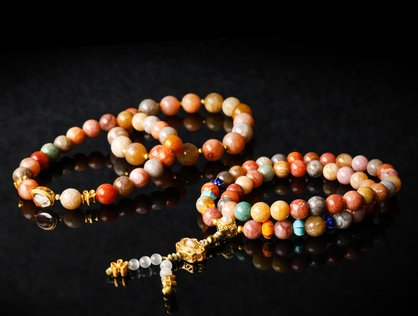What Are the Criteria for Evaluating the Grade and Quality of Coral Jade?
The grade and quality of Coral Jade vary significantly, especially in recent years, as the market price of high-quality Coral Jade has continued to rise. Coral Jade is mainly divided into three types: mountain material, water material, and semi-mountain semi-water material, with mountain material being the most abundant.
Mountain material Coral Jade is characterized by its obvious patterns and bright colors. However, most mountain material Coral Jade tends to be dry, with poor water head (transparency and gloss). It is also prone to have sand holes and uneven hardness, which affect its overall quality.
In contrast, water material Coral Jade has less obvious patterns and more subdued colors. But it excels in water head, with high transparency and gloss, fewer sand holes, and higher hardness. However, water material Coral Jade is prone to have ice cracks, which to some extent affect its aesthetic appeal and value.
Semi-mountain semi-water material Coral Jade combines the advantages of both mountain and water materials. It is extremely scarce in production, with obvious patterns, bright colors, good water head, semi-transparency, and uniform hardness. Therefore, semi-mountain semi-water material Coral Jade often has a higher value in the market.
When distinguishing the grade and quality of Coral Jade, we can start with the following aspects:
Firstly, observe the water head. Coral Jade with good water head is crystal clear and glossy; while Coral Jade with poor water head appears dry and dull. The water head of water material Coral Jade is usually better than that of mountain material, and semi-mountain semi-water material falls in between.
Secondly, pay attention to the color. Coral Jade comes in a variety of colors, including red, orange, yellow, white, and black. Coral Jade with bright and saturated colors usually has better quality. The colors of mountain material Coral Jade are often brighter, while those of water material are relatively subdued, and the colors of semi-mountain semi-water material fall in between.
Furthermore, observe the patterns. The patterns of Coral Jade vary in shape, including stripes, spots, clouds, etc. Coral Jade with clear, smooth, and symmetrical patterns is of better quality. The patterns of mountain material Coral Jade are usually more obvious, while those of water material are relatively inconspicuous, and the patterns of semi-mountain semi-water material fall in between.
In addition, sand holes and ice cracks are also important factors in judging the quality of Coral Jade. Coral Jade with many sand holes has poor quality because sand holes can affect its hardness and gloss. Similarly, Coral Jade with many ice cracks is also of poor quality because ice cracks can damage its aesthetic appeal and integrity. In this regard, mountain material Coral Jade tends to have more sand holes, water material tends to have more ice cracks, and semi-mountain semi-water material has relatively fewer of them.
Besides the above aspects, factors such as the origin and carving craftsmanship of Coral Jade can also affect its grade and quality. Therefore, when collecting Coral Jade, we need to comprehensively consider multiple factors, carefully observe and distinguish, in order to find the desired treasure.


Rose Quartz Healing for Women Anxiety Crystal Bracelet
$29.00Original price was: $29.00.$23.00Current price is: $23.00.